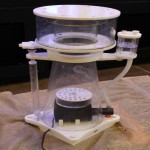Monthly Archives: June 2013

Selecting a New Skimmer
Seeing as how I just ordered a new skimmer for my 180 gallon set-up, I thought I would explain how I pick out skimmers.
Here are the three simple rules of thumb that I used to pick out a needle wheel based skimmer. These are not hard fast rules, just my own personal guidelines that I have decided to use for myself based on what I have read. Nothing really too scientific about this, just my first hand experiences combined with what I have read. You have to also keep in mind; some manufacture stated capacities are based on very specific test conditions which are not always reproducible in the average set-up resulting in a stated rating that may not always be usable or 100% applicable to real life uses. That is why I like to pick out skimmers based on the below three simple guidelines:
1. Look at the airflow ratings (Liters per hour).
The reason this is important is to try to gauge if the pump will be capable to produce a lot of fine bubbles. The higher the air rating, the better the potential performance. Although a lot of skimmers will be set to use about 10% to 25% of the maximum air intake settings on the skimmer (in liters per hour), this will still give you a somewhat usable guideline even though manufactures will state the maximum un restricted air flow the pump is capable of. Higher l/hr ratings can produce larger amounts of bubbles as well as smaller sized bubbles which are two key factors for a skimmer to work efficiently. For my set-ups, I have had great success by picking a skimmer with a L/hr that is between 5 to 10 times the total water volume of my set-ups (display tank + sump water volume)
2. Look at the water flow rating (in gallons per hour).
This is the amount of water the skimmer will move. I look at this for two reasons. The first is to make sure the skimmer will be able create strong and turbulent flow to utilize the bubbles produced and push the crud up into the skimmer cup. The second is to make sure the skimmer will be able to skim anywhere from 4 to 6 times the total water volume in the set-up. However, as the air pulled into the skimmer will offset some of the water, you must subtract at least 25% of the flow rating to get a more realistic number from the manufacture’s stated flow rate. This should give you the minimum water flow you will get out of that skimmer (worse case situation) based on average air/water mixtures. For example, if the manufacture states the skimmer pump has a flow rate of 1000 gph, you should use a flow rate of 750 gph as that is closer to the actual amount of water it will move once air has been mixed into the water.
3. Get a good quality brand name skimmer pump
Look for a good quality skimmer with a good quality skimmer pump. This will also depend on you budget to purchase a skimmer. I personally pay more attention to the skimmer pump than the brand of skimmer. Pumps such as: Sicce, Red Dragon, Diablo, and Rock rank amount the better quality skimmer pumps, but there are a lot more out there. Take the time to research the brand and read a lot of customer reviews to get some firsthand feedback.
Also, many people have their own rule of thumb about using the manufacture’s recommendations on suggested water volume ratings. Some people will say to pick a skimmer that is rated for 2 times your total water volume while others will say 1.5 times. While these suggestions can be helpful, they would be best to be used only as a starting point. In addition, that approach my work well for lower to mid quality skimmers, however, it will mostly likely be very misleading for good quality and top of the line skimmers. I would still suggest to assess the capability of the skimmer pump (using the above three guidelines) as a more accurate approach to take. As long as it can help you base your decision on a little more detailed information and less on a manufacture’s suggestions.
I also try to assume that my aquarium will always have a very high bioload. That way, I will be less likely to be up-grading my skimmer in the future. The only reason why I had to up-grade my current skimmer is that I recently up-graded the tank size but did not initially up=grade the skimmer when I went to a larger tank and sump.
When I researched and selected the new skimmer I just ordered for my 180 gallon set-up (total of 250 gallon water volume), I knew I wanted a skimmer with 1000 to 1500 GPH and 1250 to 2500 L/hr. I also wanted a very good quality brand as I have the budget that will allow for that. This certainly helped me a lot to narrow down my choices and to select my next skimmer.

Some Interesting Articles
I came across some information this week that I thought I would share here.
The below article has a pretty good ans easy to use reference chart to help better understand the needs of certain corals
http://successfulreefkeeping.com/learn/what-your-coral-needs/
Below is a good article giving you a firsthand account of one person’s experiences using tap water and RO water for their marine aquarium.
http://www.fishchannel.com/fish-blogs/fish-biz-buzz/2012/reverse-osmosis-for-making-marine-tanks.aspx
And this below article talks about the benefits of using macro algae in a marine aquarium set-up
http://www.fishchannel.com/fish-exclusives/fama/macroalgae.aspx
I also found a very interesting video about mantis shrimp. Both informative and entertaining.
http://blog.aquanerd.com/2013/06/true-facts-about-the-mantis-shrimp.html
For those of you that are interested in following new trends and designs with skimmers, the below article is a pretty good write up about the new Skimz model.
http://blog.aquanerd.com/2013/05/skimz-oval-protein-skimmer.html
A really good read about pods
http://www.aquariumdomain.com/viewArticle.php?article_id=14